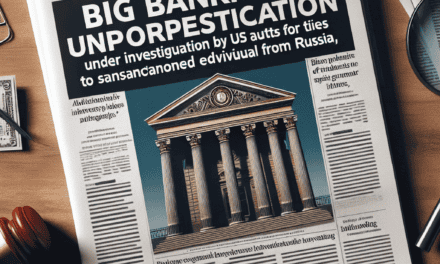“Strategic Shift: Buffett Bets Big on Stability with Massive Stock Sell-Off”
Introduction
In a strategic move that has captured the attention of investors worldwide, Warren Buffett, the legendary chairman and CEO of Berkshire Hathaway, has recently divested over 300 million shares from some of the conglomerate’s top stock holdings. This significant reallocation of assets underscores Buffett’s enduring commitment to prudent investment strategies, particularly in times of economic uncertainty. By shifting focus towards more secure and stable assets, Buffett aims to safeguard Berkshire Hathaway’s portfolio against potential market volatility, reflecting his long-standing philosophy of value investing and risk management. This decision not only highlights Buffett’s adaptive approach to changing market dynamics but also serves as a potential indicator of broader economic trends that may influence investor behavior in the coming months.
Warren Buffett’s Strategic Shift: Analyzing the Sale of Over 300 Million Shares
Warren Buffett, the legendary investor and chairman of Berkshire Hathaway, has long been a figure of fascination in the financial world. His investment decisions are closely scrutinized by analysts and investors alike, as they often signal broader trends or shifts in market sentiment. Recently, Buffett made headlines by selling over 300 million shares of some of his top stock holdings, a move that has sparked widespread speculation and analysis. This strategic shift, while surprising to some, is consistent with Buffett’s long-standing investment philosophy that emphasizes value and security.
To understand the implications of this decision, it is essential to consider the context in which it was made. The global economic landscape is currently characterized by volatility and uncertainty, driven by factors such as geopolitical tensions, fluctuating interest rates, and the lingering effects of the COVID-19 pandemic. In such an environment, investors are increasingly seeking safe havens to protect their capital. Buffett’s decision to divest from certain stocks and redirect his investments into more secure assets can be seen as a response to these prevailing conditions.
Moreover, Buffett’s investment strategy has always been rooted in the principles of value investing, which involves identifying undervalued assets with strong long-term potential. By selling a significant portion of his stock holdings, Buffett is likely freeing up capital to invest in assets that he perceives as offering better value and stability. This move aligns with his historical approach of buying low and selling high, capitalizing on market inefficiencies to generate substantial returns.
Another factor to consider is the specific stocks that Buffett chose to sell. While the exact details of these transactions have not been fully disclosed, it is known that they include shares from some of the most prominent companies in Berkshire Hathaway’s portfolio. This suggests a strategic reallocation of resources, possibly in response to changing market dynamics or shifts in the competitive landscape of these industries. By reducing exposure to certain sectors, Buffett may be positioning Berkshire Hathaway to better weather potential downturns or capitalize on emerging opportunities.
Furthermore, Buffett’s decision to invest in secure assets is indicative of a broader trend among institutional investors. In recent years, there has been a growing emphasis on risk management and capital preservation, particularly in the face of economic uncertainty. Secure assets, such as government bonds, real estate, and infrastructure projects, offer stable returns and lower risk profiles, making them attractive options for investors seeking to safeguard their portfolios.
In conclusion, Warren Buffett’s sale of over 300 million shares of top stocks represents a strategic shift that reflects both his investment philosophy and the current economic climate. By reallocating resources into secure assets, Buffett is not only responding to market volatility but also adhering to his principles of value investing. This move underscores the importance of adaptability and foresight in investment decision-making, qualities that have long defined Buffett’s illustrious career. As the financial world continues to evolve, investors will undoubtedly look to Buffett’s actions for guidance and insight, recognizing that his decisions are often harbingers of broader market trends.
Understanding Warren Buffett’s Investment Philosophy in 2023
In 2023, the financial world was abuzz with news that Warren Buffett, the legendary investor and CEO of Berkshire Hathaway, had sold over 300 million shares of top stocks to redirect his investments into what he deemed a more secure asset. This strategic move, while surprising to some, is deeply rooted in Buffett’s long-standing investment philosophy, which emphasizes value, security, and long-term growth. To understand the rationale behind this decision, it is essential to delve into the principles that have guided Buffett’s investment strategies over the decades.
Warren Buffett has always been a proponent of value investing, a strategy that involves picking stocks that appear to be undervalued by the market. This approach is grounded in the belief that the market often misprices stocks in the short term, but their true value will be recognized over the long term. By selling a significant portion of his holdings in top stocks, Buffett is likely signaling a shift in his assessment of their future value potential. This does not necessarily imply a lack of confidence in these companies but rather a strategic reallocation of resources to capitalize on emerging opportunities that align more closely with his investment criteria.
Moreover, Buffett’s decision to invest in a secure asset underscores his cautious approach to market volatility and economic uncertainty. In recent years, global markets have experienced heightened instability due to geopolitical tensions, inflationary pressures, and technological disruptions. By moving into a more secure asset, Buffett is likely seeking to mitigate risk and preserve capital, a hallmark of his investment philosophy. This move reflects his belief in the importance of maintaining a margin of safety, a concept popularized by his mentor Benjamin Graham, which involves investing in assets that offer a buffer against potential losses.
Furthermore, Buffett’s investment decisions are often influenced by macroeconomic trends and the broader financial landscape. In 2023, the global economy is undergoing significant transformations, with shifts in energy policies, technological advancements, and changing consumer behaviors. These factors may have prompted Buffett to reassess his portfolio and identify assets that are better positioned to thrive in this evolving environment. By reallocating his investments, Buffett is not only safeguarding his portfolio but also positioning it to benefit from long-term growth opportunities.
In addition to these strategic considerations, Buffett’s move can also be seen as a reflection of his commitment to ethical and sustainable investing. In recent years, there has been a growing emphasis on environmental, social, and governance (ESG) factors in investment decisions. Buffett, known for his principled approach to business, may be aligning his investments with these values by choosing assets that contribute positively to society and the environment. This alignment with ESG principles not only enhances the ethical standing of his portfolio but also taps into the increasing demand for responsible investments.
In conclusion, Warren Buffett’s decision to sell over 300 million shares of top stocks to invest in a secure asset is a testament to his adaptive and forward-thinking investment philosophy. By prioritizing value, security, and sustainability, Buffett continues to demonstrate his ability to navigate complex market dynamics and make informed decisions that ensure long-term success. As the financial landscape continues to evolve, investors around the world will undoubtedly look to Buffett’s strategies for guidance and inspiration.
Top Stocks to Consider After Warren Buffett’s Major Sell-Off
In the ever-evolving landscape of financial markets, the actions of influential investors often serve as a barometer for broader economic trends. Recently, Warren Buffett, the legendary investor and CEO of Berkshire Hathaway, made headlines by selling over 300 million shares of top stocks. This significant move has prompted investors to reassess their portfolios and consider alternative investment opportunities. As we delve into the implications of Buffett’s decision, it is crucial to explore the potential stocks that may offer promising returns in the wake of this major sell-off.
To begin with, understanding the rationale behind Buffett’s decision is essential. Known for his long-term investment strategy and value-oriented approach, Buffett’s actions are rarely impulsive. His decision to divest from certain top stocks suggests a strategic pivot towards more secure assets, possibly in response to market volatility or changing economic conditions. This shift underscores the importance of diversification and the need to adapt to evolving market dynamics.
In light of Buffett’s sell-off, investors are now keenly observing sectors that may benefit from this reallocation of capital. One area that has garnered attention is the technology sector. Despite recent fluctuations, technology companies continue to drive innovation and growth across various industries. Companies with strong fundamentals, robust revenue streams, and a track record of adaptability are likely to attract investors seeking stability and potential for long-term growth. As such, tech giants with a focus on cloud computing, artificial intelligence, and cybersecurity may present compelling investment opportunities.
Moreover, the healthcare sector remains a perennial favorite among investors, particularly in times of economic uncertainty. The ongoing advancements in biotechnology, coupled with an aging global population, create a fertile ground for growth in this sector. Companies involved in pharmaceuticals, medical devices, and healthcare services are poised to benefit from increased demand and innovation. Investors may find value in stocks that demonstrate resilience and a commitment to addressing pressing healthcare challenges.
Transitioning to another promising area, the renewable energy sector is gaining momentum as the world shifts towards sustainable practices. With governments and corporations alike prioritizing environmental responsibility, companies involved in solar, wind, and other renewable energy sources are positioned for substantial growth. As Buffett’s sell-off prompts a reevaluation of investment strategies, renewable energy stocks offer a compelling case for those seeking to align their portfolios with global sustainability trends.
Furthermore, consumer staples and essential goods companies continue to be a reliable choice for investors seeking stability. These companies provide products and services that remain in demand regardless of economic conditions, making them a safe haven during market turbulence. As Buffett’s actions highlight the importance of secure assets, consumer staples stocks may offer a balanced approach to risk management and steady returns.
In conclusion, Warren Buffett’s decision to sell over 300 million shares of top stocks serves as a reminder of the dynamic nature of financial markets. As investors navigate the implications of this major sell-off, it is crucial to consider sectors that offer resilience, innovation, and growth potential. By focusing on technology, healthcare, renewable energy, and consumer staples, investors can position themselves to capitalize on emerging opportunities while mitigating risks. Ultimately, the key lies in maintaining a diversified portfolio that adapts to changing market conditions, ensuring long-term success in an ever-evolving investment landscape.
The Impact of Warren Buffett’s Stock Sales on the Market
Warren Buffett, the legendary investor and CEO of Berkshire Hathaway, has long been a bellwether for market trends and investment strategies. His recent decision to sell over 300 million shares of top stocks has sent ripples through the financial world, prompting analysts and investors alike to scrutinize the implications of such a significant move. This strategic shift, characterized by a pivot towards more secure assets, underscores Buffett’s cautious approach in navigating the current economic landscape.
The sale of these shares, which include stakes in some of the most prominent companies, has inevitably raised questions about the underlying reasons for this decision. Historically, Buffett has been known for his long-term investment philosophy, often holding onto stocks for decades. Therefore, his choice to divest such a substantial portion of his portfolio suggests a reassessment of market conditions and potential risks. This move may reflect concerns over market volatility, geopolitical tensions, or economic indicators that signal a downturn. By reallocating capital into more secure assets, Buffett appears to be hedging against potential uncertainties that could impact the global economy.
Moreover, the impact of Buffett’s stock sales extends beyond his own portfolio. As one of the most influential figures in the investment community, his actions often serve as a barometer for other investors. Consequently, this large-scale divestment has prompted a wave of reactions across the market. Some investors may interpret Buffett’s decision as a signal to reevaluate their own holdings, potentially leading to increased volatility as they adjust their strategies. Others might view it as an opportunity to acquire shares in these top companies at a lower price, anticipating a rebound in the future.
In addition to influencing individual investors, Buffett’s actions also have implications for the companies whose shares he has sold. A significant sell-off by a major shareholder can exert downward pressure on a company’s stock price, at least in the short term. This can affect the company’s market capitalization and investor perception, potentially leading to broader strategic adjustments within the company. However, it is important to note that Buffett’s decision to sell does not necessarily reflect a lack of confidence in these companies’ long-term prospects. Instead, it may simply be a tactical move to optimize his portfolio in response to evolving market conditions.
Furthermore, Buffett’s pivot towards secure assets highlights a broader trend among investors seeking stability amidst uncertainty. In times of economic turbulence, secure assets such as bonds, gold, or real estate often become more attractive due to their perceived lower risk. By investing in these assets, Buffett is aligning with a strategy that prioritizes capital preservation over aggressive growth. This approach resonates with his well-documented aversion to unnecessary risk and his preference for investments that offer reliable returns over time.
In conclusion, Warren Buffett’s decision to sell over 300 million shares of top stocks and invest in secure assets is a significant development with far-reaching implications. It reflects a strategic response to current market conditions and serves as a potential indicator for other investors. While the immediate impact may include increased market volatility and shifts in investor sentiment, the long-term effects will depend on how the economic landscape evolves. As always, Buffett’s actions provide valuable insights into the art of navigating complex financial environments, reminding investors of the importance of adaptability and prudence in their investment strategies.
Secure Asset Investment Strategies Inspired by Warren Buffett
Warren Buffett, often regarded as one of the most successful investors of all time, has recently made headlines by selling over 300 million shares of top stocks to redirect his investment strategy towards a more secure asset. This move has sparked considerable interest and speculation among investors and financial analysts alike, as they seek to understand the rationale behind such a significant shift in his investment portfolio. By examining Buffett’s recent actions, investors can glean valuable insights into secure asset investment strategies that may prove beneficial in today’s volatile market environment.
To begin with, it is essential to understand the context in which Buffett decided to sell a substantial portion of his stock holdings. The global financial landscape has been marked by uncertainty, with fluctuating market conditions and geopolitical tensions contributing to increased volatility. In such an environment, even seasoned investors like Buffett are prompted to reassess their portfolios to mitigate risk and preserve capital. By divesting from certain top stocks, Buffett is likely seeking to reduce exposure to market fluctuations and safeguard his investments against potential downturns.
Transitioning from stocks to secure assets is a strategy that aligns with Buffett’s long-standing investment philosophy, which emphasizes the importance of capital preservation and long-term growth. Secure assets, often characterized by their stability and lower risk profile, provide a hedge against market volatility. These assets can include government bonds, real estate, and precious metals, among others. By reallocating his investments into such assets, Buffett is not only protecting his capital but also positioning himself to take advantage of potential opportunities that may arise in the future.
Moreover, Buffett’s decision underscores the importance of diversification in investment strategies. While stocks have historically offered substantial returns, they are also subject to market cycles and economic shifts. By diversifying into secure assets, investors can achieve a more balanced portfolio that is better equipped to weather economic uncertainties. This approach not only reduces risk but also enhances the potential for steady returns over time. Buffett’s actions serve as a reminder that diversification remains a cornerstone of sound investment strategy, particularly in times of economic unpredictability.
In addition to diversification, Buffett’s move highlights the significance of adaptability in investment strategies. The financial markets are dynamic, and successful investors must be willing to adjust their strategies in response to changing conditions. By selling a large number of shares and investing in secure assets, Buffett demonstrates a proactive approach to managing his portfolio. This adaptability is crucial for investors seeking to navigate the complexities of the modern financial landscape and achieve sustainable growth.
Furthermore, Buffett’s investment shift offers a lesson in the value of patience and long-term thinking. Secure assets may not provide the rapid returns that stocks can offer, but they contribute to a more stable and resilient portfolio over time. Buffett’s focus on long-term growth rather than short-term gains is a testament to his disciplined investment approach, which has consistently yielded success throughout his career.
In conclusion, Warren Buffett’s decision to sell over 300 million shares of top stocks in favor of secure assets provides valuable insights into effective investment strategies. By prioritizing capital preservation, diversification, adaptability, and long-term thinking, investors can draw inspiration from Buffett’s actions to navigate the complexities of today’s financial markets. As the global economic landscape continues to evolve, these principles remain essential for achieving sustainable investment success.
Lessons from Warren Buffett’s Recent Portfolio Adjustments
Warren Buffett, the legendary investor and CEO of Berkshire Hathaway, has long been a beacon of wisdom in the financial world. His investment strategies are closely watched by both novice and seasoned investors alike, as his decisions often reflect broader market trends and economic insights. Recently, Buffett made headlines by selling over 300 million shares of top stocks, a move that has sparked widespread discussion and analysis. This significant portfolio adjustment offers several lessons for investors, particularly in understanding the rationale behind reallocating assets and the importance of adapting to changing market conditions.
To begin with, Buffett’s decision to divest such a substantial number of shares underscores the importance of reassessing one’s investment portfolio regularly. Markets are inherently dynamic, influenced by a myriad of factors including economic indicators, geopolitical events, and technological advancements. By selling a large volume of shares, Buffett demonstrates the necessity of staying vigilant and responsive to these changes. This proactive approach allows investors to mitigate risks and capitalize on emerging opportunities, ensuring that their portfolios remain aligned with their long-term financial goals.
Moreover, Buffett’s move highlights the significance of diversification and the strategic reallocation of assets. While the specific stocks sold have not been disclosed, it is evident that Buffett is shifting his focus towards more secure investments. This transition suggests a cautious outlook on the current market environment, possibly due to concerns over volatility or overvaluation in certain sectors. By reallocating funds into secure assets, Buffett is effectively hedging against potential downturns, thereby safeguarding his portfolio from unforeseen market fluctuations. This strategy serves as a reminder to investors of the value of maintaining a balanced and diversified portfolio, which can provide stability and resilience in uncertain times.
In addition to diversification, Buffett’s actions emphasize the importance of investing in secure assets, particularly during periods of economic uncertainty. Secure assets, such as bonds or stable dividend-paying stocks, offer a degree of predictability and safety that can be appealing when market conditions are volatile. By prioritizing these types of investments, Buffett is reinforcing the principle of capital preservation, which is a cornerstone of his investment philosophy. This approach is especially relevant for investors who are risk-averse or nearing retirement, as it provides a reliable income stream while minimizing exposure to market risks.
Furthermore, Buffett’s recent portfolio adjustments serve as a testament to the value of patience and long-term thinking in investing. While short-term market movements can be unpredictable and often driven by sentiment, Buffett’s strategy is rooted in a disciplined, long-term perspective. By focusing on secure assets, he is positioning his portfolio to weather potential economic storms and emerge stronger in the future. This mindset encourages investors to look beyond immediate market fluctuations and remain committed to their investment objectives, even in the face of uncertainty.
In conclusion, Warren Buffett’s decision to sell over 300 million shares of top stocks and invest in secure assets offers valuable insights for investors. It underscores the importance of regular portfolio reassessment, diversification, and the strategic allocation of assets to mitigate risks. Additionally, it highlights the significance of investing in secure assets and maintaining a long-term perspective. As investors navigate the complexities of the financial markets, these lessons from Buffett’s recent portfolio adjustments can serve as a guiding framework for making informed and prudent investment decisions.
How Warren Buffett’s Moves Influence Investor Confidence
Warren Buffett, the legendary investor and chairman of Berkshire Hathaway, has long been a beacon of wisdom and stability in the financial world. His investment decisions are closely watched by both individual and institutional investors, often serving as a barometer for market sentiment. Recently, Buffett made headlines by selling over 300 million shares of top stocks, a move that has sparked widespread discussion and analysis. This decision, while surprising to some, is consistent with Buffett’s long-standing investment philosophy, which emphasizes value and long-term growth over short-term gains.
The sale of such a significant number of shares naturally raises questions about the underlying reasons and potential implications for the market. Buffett’s decision to divest from these top stocks suggests a strategic pivot, possibly in response to changing market conditions or emerging opportunities. Historically, Buffett has been known to adjust his portfolio in anticipation of economic shifts, and this move may indicate his assessment of current market valuations as being overly inflated. By reallocating capital, Buffett is likely positioning Berkshire Hathaway to capitalize on more secure and potentially undervalued assets.
In the wake of this substantial divestment, Buffett has redirected his focus towards what he perceives as a more secure asset. While the specifics of this new investment have not been fully disclosed, it is clear that Buffett’s strategy is driven by a desire to safeguard capital while still seeking reasonable returns. This approach aligns with his well-documented preference for investments that offer stability and resilience, particularly in uncertain economic climates. By prioritizing secure assets, Buffett is reinforcing his commitment to preserving wealth over the long term, a principle that has guided his investment decisions for decades.
The impact of Buffett’s moves on investor confidence cannot be overstated. As one of the most respected figures in finance, his actions often serve as a catalyst for broader market trends. When Buffett sells a substantial portion of his holdings, it can signal to other investors that it may be time to reassess their own portfolios. This ripple effect can lead to increased market volatility as investors react to perceived shifts in market dynamics. However, it is important to note that Buffett’s decisions are based on his unique perspective and analysis, which may not necessarily align with the views of other market participants.
Moreover, Buffett’s investment choices underscore the importance of adaptability in the ever-evolving financial landscape. By remaining flexible and open to new opportunities, investors can better navigate the complexities of the market. Buffett’s willingness to pivot and explore secure assets serves as a reminder that even seasoned investors must remain vigilant and responsive to changing conditions. This adaptability is crucial for maintaining investor confidence, as it demonstrates a proactive approach to managing risk and optimizing returns.
In conclusion, Warren Buffett’s recent sale of over 300 million shares and subsequent investment in a secure asset highlights his strategic acumen and commitment to long-term value. While his actions may initially unsettle some investors, they ultimately reinforce the importance of thoughtful, informed decision-making in the pursuit of financial success. As the market continues to evolve, Buffett’s moves will undoubtedly continue to influence investor confidence, serving as a testament to his enduring legacy in the world of finance.
Q&A
1. **What stocks did Warren Buffett sell?**
Warren Buffett, through Berkshire Hathaway, sold shares of top stocks such as Apple, Wells Fargo, and JPMorgan Chase.
2. **How many shares did Warren Buffett sell?**
Warren Buffett sold over 300 million shares.
3. **Why did Warren Buffett sell these shares?**
The sale was likely part of a strategy to rebalance the portfolio and invest in more secure or undervalued assets.
4. **What is the significance of selling these stocks?**
Selling such a large number of shares can indicate a shift in investment strategy or a response to market conditions.
5. **What are secure assets?**
Secure assets typically refer to investments considered low-risk, such as bonds, treasury securities, or stable dividend-paying stocks.
6. **How does this sale impact the stock market?**
Large sales by influential investors like Buffett can lead to fluctuations in stock prices and influence market sentiment.
7. **What might be Warren Buffett’s next investment move?**
While specific future moves are speculative, Buffett may focus on undervalued stocks, secure assets, or sectors with long-term growth potential.
Conclusion
Warren Buffett’s decision to sell over 300 million shares of top stocks to invest in secure assets reflects a strategic shift towards risk management and capital preservation. This move suggests a cautious outlook on the current market conditions, possibly anticipating volatility or overvaluation in certain sectors. By reallocating capital into more secure assets, Buffett aims to safeguard his portfolio against potential downturns while maintaining the flexibility to capitalize on future investment opportunities. This strategy underscores his long-term investment philosophy of prioritizing stability and value over short-term gains.





